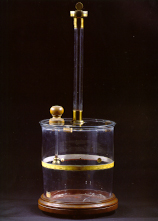
65.5 x 26
Glass, wood, elder pith and brass
CAT. 1878 : 341
Balança de torsão de Coulomb.
Coulomb torsion balance.
The Coulomb torsion balance occupies an extremely important place in the history of Physics. It is an instrument that enables us to verify experimentally the quantitative law of interaction between electrical charges. Generally speaking, the balance comprises a cylindrical or square glass case, closed by a lid from which a glass tube emerges. The tube ends with a piece of metal from which a torsion thread is suspended. This thread holds a horizontal needle made of lac, with a small vertical brass disc at one end and a sphere of elder pith at the other. The height of the needle is adjusted by a knob which is turned to wind the suspending thread on a horizontal axis. This axis is mounted on a revolving disc on which is engraved a scale divided in degrees. The scale progresses in relation to a reference mark, fixed on the glass column, so that the angular displacement can be measured.
To study the intensity of the interaction force between two charged bodies, the brass disc is made to touch a small metal sphere which is on the end of a glass rod suspended from a hole in the glass lid of the balance. In these conditions, both the disc and the sphere are without charge and the thread suspending the needle should not be under torsion. Next, the sphere suspended from the lid of the balance is removed, to be electrically charged. This sphere, on being put back in the balance, touches the brass disc giving it the same charge and, consequently, they repel one another.
When this occurs, the needle begins a damped oscillating motion until it stops. The instrument remains static in a position corresponding to the equilibrium between the moment of the force of repulsion and that of torsion of the thread. The torsion angle of the thread is measured on the degree scale marked on the glass case, at the same height of the horizontal plane of the suspended needle.
On turning the disc from which the thread holding the needle is suspended, bringing the disc closer to the sphere, the torsion angle increases, since both have the same charge. The new distance between the charged bodies can be obtained by means of the scale on the casing of the balance. Recording successive angles of torsion for the thread, for the corresponding distances between the sphere and the disc permit observation of the ratio between the intensity of the force of repulsion and the square of the distance between the charged bodies.
In order to ascertain the ration between the interaction force and the electrical charge on the bodies, Coulomb used a ball of elder pith suspended on the needle. After recording the torsion angle of the suspension thread, as before, the sphere suspended on the glass rod is withdrawn and placed in contact with another of the same size. This operation resulted in its charge being reduced by half. On being replaced in the balance, the electric repulsion between the metal sphere and the elder pith ball is less strong. The new torsion angle of the thread, corresponding to the new equilibrium position, is less than in the previous case. If this procedure is repeated several times, a valid experimental ratio is obtained.
Besides these experiments, Coulomb developed other experimental methods based on the measurement of the oscillation periods of the needles suspended on the torsion thread. This was the method he employed to calibrate the threads used in torsion balances.
For the experiments to work well, the interior of the balance had to be dried. A dish of anhydrous lime was used for this purpose.
The instrument in the Gabinete de Física, has a cylindrical case and is now incomplete. It was acquired in 1869.
Daguin, Pierre-Adolphe, Traité Élémentaire de Physique Théorique et Expérimentale, Paris, 1878, Vol. III, nº. 1618.